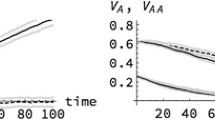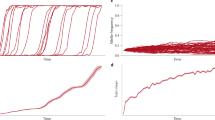Abstract
Quantitative genetic theory predicts that variation due to rare alleles at many loci will generate a transient acceleration in the response to directional selection. We have tested this prediction by constructing experimental lines ofDrosophila melanogaster that carry positively selected ethanol resistance alleles at low frequencies, and then subjecting the lines to directional selection for ethanol resistance. Approximately 468,000 files were subjected to artificial selection over 30 generations. The predicted non-linear selection responses were observed in all experimental lines and replicates, on three genetic backgrounds. In contrast, un-selected controls and lines carrying random alleles at low frequencies on the same genetic backgrounds exhibited linear selection responses. These results demonstrate that non-linearities due to rare alleles are detectable and repeatable, provided that experiments are done on a sufficiently large scale. The results suggest that it may be possible to test for rare-alleles as a component of naturally occurring genetic variation by careful examination of selection response curves.
Similar content being viewed by others
References
Barton, N.H. & M. Turelli, 1987. Adaptive landscapes, genetic distance, and the evolution of quantitative characters. Genet. Res. Camb. 49: 157–174.
Barton, N.H. & M. Turelli, 1989. Evolutionary quantitative genetics: how little do we know? Ann. Rev. Genet. 23: 337–370.
Falconer, D.S., 1989. Introduction to Quantitative Genetics, 3rd Edition. Longman Scientific and Technical, New York.
Fisher, R.A., 1958. The Genetical Theory of Natural Selection, 2nd. edition. Dover, New York.
Fleming, W.H., 1979. Equilibrium distributions of continuous polygenic traits. SIAM J. Appl. Math. 36: 148–168.
Frankham, R. 1980. The founder effect and response to artificial selection inDrosophila, pp. 87–90 in Selection Experiments in Laboratory and Domestic Animals, edited by A. Robertson. Commonwealth Agricultural Bureau, Slough, UK.
James, J.W., 1971. The founder effect and response to artificial selection. Genet. Res. Camb. 16: 241–250.
Lande, R., 1975. The maintenance of genetic variation by mutation in a polygenic character with linked loci. Genet. Res. Camb. 26: 221–235.
Lande, R., 1987. Quantitative genetics and evolutionary theory, in Proceedings of the Second International Conference on Quantitative Genetics, edited by B.S. Weir, E.J. Eisen, M.M. Goodman, & G. Namkoong. Sinauer Associates, Inc., Sunderland, Mass.
Nagylaki, T., 1984. Selection on a quantitative character, pp. 275–306 in Human Population Genetics: The Pittsburgh Symposium, edited by A. Chakravarti. Van Nostrand Reinhold, New York.
Slatkin, M., 1987. Heritable variation and heterozygosity under a balance between mutations and stabilizing selection. Genet. Res. Camb. 50: 53–62.
Turelli, M., 1987. Quantitative genetics, ecology, and evolution, in Proceedings of the Second International Conference on Quantitative Genetics edited by B.S. Weir, E.J. Eisen, M.M. Goodman & G. Namkoong. Sinauer Associates, Inc., Sunderland, Mass.
Turelli, M., 1984. Heritable genetic variation via mutation-selection balance: Lurch's zeta meets the abdominal bristle. Theor. Pop. Biol. 25: 138–193.
Weber, K.E., 1986. The effect of population size on response to selection. Ph.D. thesis, Harvard University.
Weber, K.E., 1988. A system for rapid morphometry of whole, live flies. Drosophila Information Serv. 76: 97–102.
Weber, K.E., 1990a. Artificial selection on wing allometry inDrosophila melanogaster. Genetics 126: 975–989.
Weber, K.E., 1990b. Increased selection response in larger populations. I. Selection for wing-tip height inDrosophila melanogaster at three population sizes. Genetics 125: 579–584.
Weber, K.E. & L.T. Diggins, 1990. Increased selection response in larger populations. II. Selection for ethanol vapor resistance inDrosophila melanogaster at two population sizes. Genetics 125: 585–597.
Wright, S., 1935. Evolution in populations in approximate equilibrium. J. Genet. 30: 257–266.
Author information
Authors and Affiliations
Rights and permissions
About this article
Cite this article
Curtsinger, J.W., Ming, R. Non-linear selection response inDrosophila: a strategy for testing the rare-alleles model of quantitative genetic variability. Genetica 99, 59–66 (1997). https://doi.org/10.1007/BF02259498
Received:
Accepted:
Issue Date:
DOI: https://doi.org/10.1007/BF02259498




